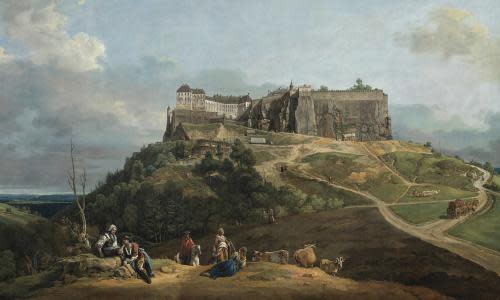Little Canaletto’s sordid city in the sky – Bellotto: The Königstein Views Reunited review

We like to identify great upheavals in the arts with new centuries. So Romanticism began on 1 January 1800? Well, Turner and Beethoven were well into their stride by then. And modernism came along on the same date in 1900? Hmm, that makes it hard to account for Van Gogh, Munch and Cézanne. The National Gallery’s small but seismic summer exhibition exposes how shallow this thinking is. It does so by bringing together five scenes by a forgotten 18th-century artist, Bernardo Bellotto, whose depictions of deepest Germany, painted in 1756-58, are the first true stirrings of Romantic storminess.
A name inscribed on the frame of one of the paintings reveals why Bellotto has been so neglected: it calls him Il Canalettino, Little Canaletto, because he was the overshadowed nephew and pupil of the famous painter of the carnivals, gondolas, piazzas and waters of 18th-century Venice. But Bellotto went north, and used the skills his uncle taught him to paint a less picturesque, more troubled Europe.
Bellotto found himself caught up in the seven years war, a little known but brutal conflict that’s depicted with unforgettable irony in Stanley Kubrick’s film Barry Lyndon. Bellotto’s employer, Frederick Augustus II, elector of Saxony and king of Poland, had to hole up in the hulking fortress of Königstein when Frederick the Great of Prussia advanced on his capital Dresden. Bellotto followed and set out to record this place of safety in hallucinatory detail, across multiple canvases – even though, by the time he finished the elector was long gone, having fled to Poland.
Bellotto’s five craggy, uneasy paintings, brought together for the first time since the 1700s, are intensely subjective, in a way that’s precociously Romantic. He finds mystery and the mirror of his own solitude in this enormous German fortress. In his eyes, it becomes a sublime icon. Each of these big paintings studies it from a different viewpoint: he looks from the north, the north-west and south-west, and surveys the courtyard from two points of view. What’s fascinating – and curiously modern – is that Bellotto’s precise perspectives don’t add up to a complete mapping of the sprawling schloss: it is just too much of a conundrum to be comprehended even in a whole series of epic pictures. Out of empiricism’s failure comes poetry.
A delicate white kiosk balances on a cliff edge among green trees, suggesting this has become a pleasure park, but near it is a much older tower from days of feudal war. The fortress appears daunting from certain angles, oddly elegant from others. Which is the real mood: coffee and Handel concerts – or defensive might?
The works have an aura of decay that might suggest Dracula’s castle, if there wasn’t so much life here. It looks as if the entire Dresden court are whiling away their time in the castle precincts, waiting for the Prussians to come. In one view, bewigged men and women with parasols enjoy the sunshine. Groups and couples walk on manicured lawns. In the foreground, a man is reaching for his wallet as he makes an agreement with a young woman, a Hogarthian touch amid the splendour. The National Gallery has discovered that the fortress, that venerable building behind them, was used as a boozer in the 1750s, with a 60,000-gallon wine cask in its cellar. There’s a gathering of ragamuffins at its door, eager to drown their sorrows.
Bellotto has not painted a citadel but a city. You can take the artist out of Venice but not Venice out of the artist. He sees Königstein as a human organism, a living city in the sky, just as his uncle revealed the mysterious shadows and seedy corners of Venetian life beyond the Grand Canal. Bellotto captures the showiness and status obsessions of the little walled city on a rock, but sees it all as fragile and fake.
Centuries later, the fragments of his unique vision have been lovingly reassembled. Here is an artist finding heartache and awe in the rocks, walls and dark windows of an enigmatic castle in paintings that look forward to Turner’s depictions of Welsh ruins or, for that matter, Rothko’s ever-darkening abyss. You may never have looked at Bellotto’s art before, but if you see this, all these images in one show, you won’t ever forget them. Curated by Letizia Treves who was also behind the National’s Artemisia Gentileschi show, this is a very different, but equally eye-opening revelation of how much there is to discover in the other countries of the past.
• At the National Gallery, London, from 22 July to 31 October.

 Yahoo News
Yahoo News 